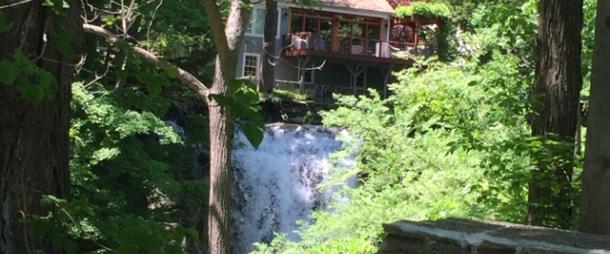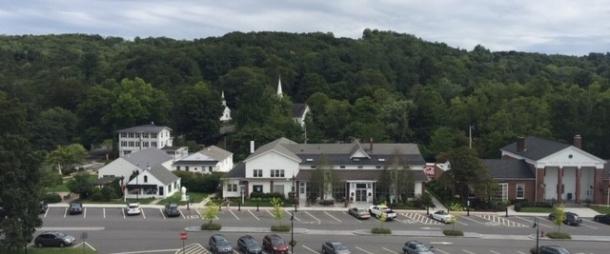History of WAA
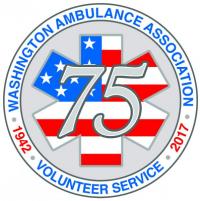 The History of Washington Ambulance Association
The History of Washington Ambulance Association
In 1941 a group of civic-minded residents came together with the idea of providing ambulance service in the town of Washington, Connecticut. They formed the Lions Club of Washington and in 1942 the Washington Lions Club incorporated the Washington Ambulance Association. The Lions Club provided the funding for Washington Ambulance Association (WAA); the members of WAA ran the ambulance and belonged to both organizations. A used Packard ambulance like the one pictured below was purchased and the local doctor was signed on to help.
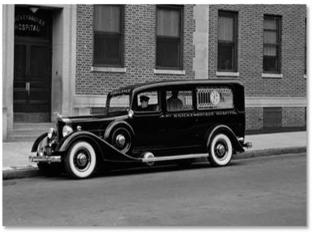
In 1942, 911 had not yet been established. The members set up a “phone tree” and a call to the emergency number used by the Fire Department could now get emergency medical assistance. That number is still held by the Town and kept in service as a backup emergency number. For a medical emergency, Doc Simonds and/or his nurse would be called and WAA members were located to pick up the rig and respond where needed. The patient was loaded into the back of the ambulance and taken to New Milford Hospital.
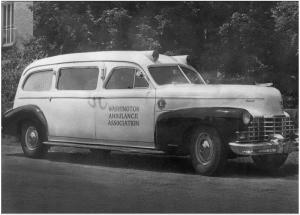
Eventually, a Cadillac ambulance replaced the Packard. When the Cadillac was retired it was followed by another Cadillac, which became one of the last two Cadillac ambulances operated in the State of Connecticut. The ambulances were housed in an addition built off the back of the Fire House in Bryan Plaza. The second Cadillac had two-way radios installed along with the medical equipment and cot. It is pictured below:
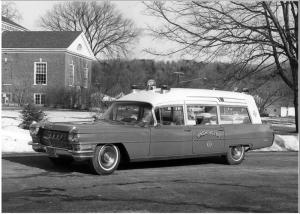
One function of the new radio system was the HEAR system used by some of the hospitals in the state. It was a high band system allowing communication between the hospitals, some dispatch centers and some ambulances. WAA also obtained a license for their own high band radio frequency used for dispatch and communication with the dispatcher. The ambulance personnel could then be dispatched by pager or by plectron. That frequency (158.775) is now used by the Town of Washington and shared by the Town Highway Department, Washington Fire, Washington Police, and Washington Ambulance. Doug Graves (Grandpa Snazzy); dispatched the ambulance. He ran a local answering service along with his antique business. Over the years, dispatch eventually changed to New Milford Answering Service and then to Litchfield County Dispatch who we continue to use today.
In the late 1960’s and early 1970’s there was a nationwide push to provide special training for the people operating ambulances. There had been no government requirements for training before then, and medical professionals generally staffed ambulances when available and otherwise by people with any first aid training. The original certification training for people operating ambulances was outlined by the National Highway Traffic Administration as an 81-hour course in care and transportation of the sick and injured. The first Emergency Medical Technicians in the State of Connecticut were trained and certified in 1972 to meet those course requirements. A couple years later the State then required a minimum of EMT level certification to staff an ambulance. EMT training now takes about a minimum of 140 hours for Basic level certification; this does not include any continuing education in the future. These changes had a major impact on staffing for WAA. Not all the members of the Lions Club were interested in obtaining the training required to go on ambulance calls. While all members of the Lions Club of Washington are also members of WAA, WAA had to start taking members who were certified as EMT’s but did not belong to the Lions. Today, while the Lions Club still provides direction and some funding, very few of our ambulance personnel are Lions Club members.
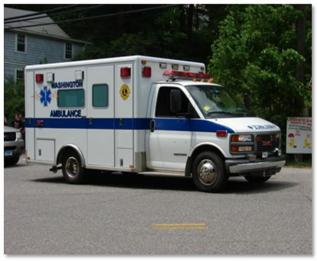
A “box type” ambulance built by Wheeled Coach on a Ford van chassis replaced the second Cadillac. It provided a major improvement in working space and equipment storage capacity and we have stayed with the “box type” ambulances since then. Hortan Ambulance built the following two ambulance vehicles. The first was built on a Ford truck chassis and the second, on a GMC truck chassis. The “box type” ambulances were fitted out with an additional, new radio system. A statewide UHF system was put together and all ambulances were required to invest in the equipment. This system is a combination of radio towers and phone lines which allow us to speak directly with any emergency room, dispatch center or another ambulance in the state. It also allows for the cross connection of radio frequencies and/ or phone lines. In theory we can speak to anyone we might need to as long as the radio on the ambulance can access one of the antenna towers for the system.
When the new Firehouse was built we changed our quarters. The ambulance is now located in the end bay of the firehouse on Bee Brook Road and we have an office and some storage space there. We share the meeting room, kitchen and squad room with the Fire Department and work closely with them on many emergency calls.
The Washington Ambulance Association of today is very fortunate in having highly trained & dedicated personnel available day and night. Our goal is to have medical personnel on the scene as quickly as possible. To this end, we operate a First Responder System. The normal procedure is to respond to the scene of the emergency if that would be closer than responding to Headquarters. All WAA members are issued “jump kits” to be carried in their personal vehicles so that they are able to respond directly to the scene of an emergency. These jump kits are equipped with more medical supplies than the actual ambulance carried in the early days. All WAA members carry 2-way radios so they may stay in contact with dispatch and each other. When a legal crew of at least one EMT & one EMR have assembled in quarters - the ambulance will move to the scene. In the event that there are multiple calls simultaneously, the Washington Volunteer Fire Department responds with a crew of medically trained personnel on Rescue One or Rescue Two to assist our Ambulance First Responders. In addition, WAA has access to the regional paramedic as well as Life Star Aero-Medical Helicopter.
Our current ambulances (pictured below) are "A1", a Lifeline 2006 Ford E-450 SD and "A2" a Lifeline 2016 Ford F-450 4WD that went into service in December of 2016. A2 has been outfitted with a Stryker Power Cot and a Power Load System. These latest innovations assist greatly in moving patients safely in and out of the ambulance. We are also carry a 12 Lead Electrocardiogram (also ECG or EKG) on each ambulance which allows us to record the electrical activity of the heart and transmit this vital information to the doctor at the receiving hospital while en route. This information, delivered as quickly as possible, can make all the difference in determining the best treatment for the critical care patient. In January of 2016 we added a very important piece of medical equipment to our ambulance by purchaing a LUCAS 2 Chest Compression Device. This is a life-saving machine which allows us to deliver superior CPR to patients in cardiac arrest.

2015 was a record year for our ambulance being dispatched to 371 emergency calls. 2017 will go down in history as an exciting year for Washington Ambulance Association in many ways. Most noteworthy is the upgrade in responsiveness now that we have two ambulances in our fleet. We also celebrated the 75th anniversary of our first call - February 15, 2017!
We look toward a bright future as we celebrate our past.











